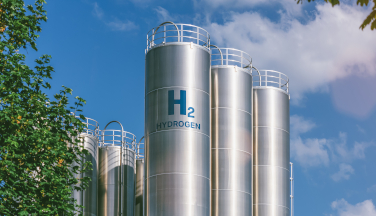Hydrogen Fuel for Internal Combustion Engines
See what everyone’s talking about


In the race to meet aggressive emission reduction mandates, automotive and heavy duty OEMs around the globe have intensified their search for lower carbon alternative fuels that can replace traditional gasoline and diesel engines in the near future. Among the many alternative fuels researchers are exploring, hydrogen has emerged as a possible leading contender. The feasibility of hydrogen fuel cells for electric vehicles is well established, with some light duty and passenger cars already on the road. More recently, however, attention has shifted to hydrogen’s potential to power internal combustion engines (ICEs).
Hydrogen is a chemical energy carrier that can serve as a fuel for combustion, similar to gasoline or natural gas. It is commonly viewed as a fuel for spark-ignition engines, with a very high flame-speed and high energy density. Three main factors are likely to accelerate investment in and development of hydrogen as an automotive fuel:
- It is widely recognized as a fuel that does not produce greenhouse gas tailpipe emissions.
- While some modifications to engine design and components are necessary, most of the base engine architecture is virtually the same as in gasoline or diesel engines. This makes it much easier for OEMs to adapt their existing engine production facilities to the manufacture of hydrogen-powered ICEs –unlike, for example, battery electric vehicles (BEVs), which require a complete re-tooling of the production line.
- The heavy-duty trucking industry is reportedly largely in favor of hydrogen ICEs as the low-risk, near-term route, and a number of truck manufacturers have announced plans to build hydrogen-fueled vehicles.
Moreover, hydrogen is one of the most abundant elements found in nature, making it a potential long-term energy solution. Hydrogen fuel can be produced by a variety of methods, notably water electrolysis using renewable energy sources such as wind or solar.
Reducing the carbon intensity of the production process will be key to realizing the promised environmental benefits, and ultimately to widespread acceptance by OEMs, the heavy-duty industry and the driving public.
There are, of course, a few obstacles. As with other alternative fuels, such as natural gas or biofuels, the fueling infrastructure needs to be developed in parallel to the fuel technology itself. We are a long way from hydrogen stations becoming as ubiquitous as gas and diesel pumps. This will entail substantial investments as well as a shared industry conviction that hydrogen fuel will become commercially viable at scale sooner rather than later. That said, European and North American fuel producers have started building the necessary infrastructure. Chevron, for example, has announced an investment to co-develop 30 hydrogen fueling sites in California by 2026.
In addition, legislation in the U.S. has been more favorable to true zero-emission technologies, such as BEVs, which suggests that progress on H2 ICE powered vehicles will be slower in the U.S. than in the rest of the world. In contrast, under proposed legislation in the EU, hydrogen would be classified as meeting the zero-emission standard of less than five grams of CO2 emissions per 10 kilometers. China, Japan and India are taking a more aggressive approach to encourage use of hydrogen fuel for a variety of applications.
For lubricant manufacturers, significant research is underway to determine the impact on automotive and heavy-duty engine oil formulations. That will depend largely on where OEMs land on the engine technology and architecture, which is still a work in progress. It will also depend on different applications – on-highway, long-haul, stop-and-go on city streets, or off-road. As a starting point, lubricants must meet the standards for engine cleanliness, wear protection, oxidation stability, and other performance characteristics that fleet operators demand. Beyond that, researchers are trying to anticipate any unique lubrication challenges hydrogen-powered ICEs may pose. Just as one example, when hydrogen reacts with oxygen, water is produced. Existing oils and potential formulations need to be tested for their ability to handle water and mitigate any harmful effects on engine components.
At Chevron Lubricants, we are working closely with industry colleagues, OEMs and our additive partners to develop solutions suited to hydrogen-fueled engines. Our goal is to be ready with versatile solutions that can support a wide range of applications. We also recognize the need for operators of mixed fleets running on a variety of conventional and alternative fuels to manage their lubricant inventories and costs.
Hydrogen fuel for ICEs holds the promise of zero tailpipe carbon emissions. It is currently one of many alternatives Chevron is pursuing as part of our strategy to advance a lower carbon future. Watch this space for further updates on the development of hydrogen as a viable alternative fuel.
10/04/2023

























